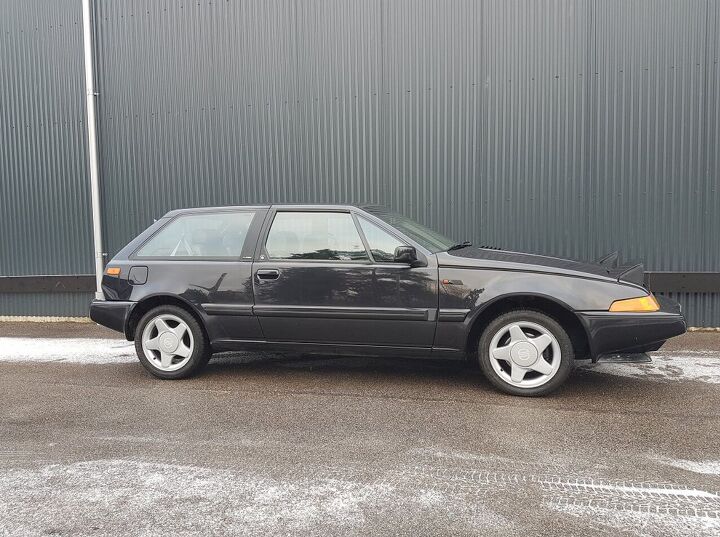Rare Rides: The Volvo 480 of 1993, Which Doesn't Look Like a Volvo

Occasionally on the vast and wondrous expanse of the Internet of Cars, I’ll run across one of these uniquely shaped little Volvos. In past instances they were either not for sale, were lacking in condition, or had few available photos.
All that changed the other day, when I sought out a photo of the 480 to make a point on Twitter. Let’s check out this charcoal-colored box, shall we?
The North American market became intimately acquainted with front-drive Volvos starting with the 850 model, introduced for the 1993 model year as a replacement for the ancient and lovable 240. In every other market, though, Volvo offered a front-drive car for some time. The 480 was said car, and was in fact the first ever front-drive vehicle from the Swedish brand.
Europeans could buy the 480 starting in 1987, where it was advertised as a sporty coupe. Volvo planned to sell the 2+2 480 to North Americans in late ’87 as a “sports wagon,” in the same vein and style as Nissan’s contemporary Pulsar Sportbak. Currency valuations had other ideas for Volvo, as the weak U.S. dollar meant importing the Netherlands-built 480 was not financially viable.
Known as the spiritual successor to the classic P1800 hatchback, the 480’s targeted buyer was the young and educated consumer. Said consumers (yuppies) wanted a sporty and stylish vehicle with advanced electronics — something Volvo hadn’t offered in prior models. Sticking to the mission, the 480 appeared more Japanese than perhaps it should (pop-up headlamps!), and certainly wasn’t Volvo-like.
Leave your cardigan at home, this Volvo’s for fun people!
Throughout the long production of the 480, Volvo made incremental changes — adding a turbo, revising interior features, and offering new color schemes. Special editions like the TwoTone (self-explanatory) and limited Celebration model rounded out the 480’s life, as production wrapped up near the end of 1995. Volvo would try this same formula again about a decade later, when the small, premium hatchback C30 hit dealer lots.
Today’s 1993 example is suitably located in Växjö, Sweden, at the southern tip of the country. In Turbo trim, the 2.0 inline-four makes 120 horsepower, and shifts through a five-speed manual. This one seems well equipped, with a two-tone leather interior in serviceable condition. Interesting that the safety-conscious Swedes still sold cars in other markets without airbags, even in 1993.
The 480 is yours for a little over $4,600, and is old enough to qualify for importation.
[Images: seller]

Interested in lots of cars and their various historical contexts. Started writing articles for TTAC in late 2016, when my first posts were QOTDs. From there I started a few new series like Rare Rides, Buy/Drive/Burn, Abandoned History, and most recently Rare Rides Icons. Operating from a home base in Cincinnati, Ohio, a relative auto journalist dead zone. Many of my articles are prompted by something I'll see on social media that sparks my interest and causes me to research. Finding articles and information from the early days of the internet and beyond that covers the little details lost to time: trim packages, color and wheel choices, interior fabrics. Beyond those, I'm fascinated by automotive industry experiments, both failures and successes. Lately I've taken an interest in AI, and generating "what if" type images for car models long dead. Reincarnating a modern Toyota Paseo, Lincoln Mark IX, or Isuzu Trooper through a text prompt is fun. Fun to post them on Twitter too, and watch people overreact. To that end, the social media I use most is Twitter, @CoreyLewis86. I also contribute pieces for Forbes Wheels and Forbes Home.
More by Corey Lewis
Latest Car Reviews
Read moreLatest Product Reviews
Read moreRecent Comments
- Brian Uchida Laguna Seca, corkscrew, (drying track off in rental car prior to Superbike test session), at speed - turn 9 big Willow Springs racing a motorcycle,- at greater speed (but riding shotgun) - The Carrousel at Sears Point in a 1981 PA9 Osella 2 litre FIA racer with Eddie Lawson at the wheel! (apologies for not being brief!)
- Mister It wasn't helped any by the horrible fuel economy for what it was... something like 22mpg city, iirc.
- Lorenzo I shop for all-season tires that have good wet and dry pavement grip and use them year-round. Nothing works on black ice, and I stopped driving in snow long ago - I'll wait until the streets and highways are plowed, when all-seasons are good enough. After all, I don't live in Canada or deep in the snow zone.
- FormerFF I’m in Atlanta. The summers go on in April and come off in October. I have a Cayman that stays on summer tires year round and gets driven on winter days when the temperature gets above 45 F and it’s dry, which is usually at least once a week.
- Kwik_Shift_Pro4X I've never driven anything that would justify having summer tires.








































Comments
Join the conversation
Stupid 25-year rule. If they sold it here, I would have bought one and tried to keep it running with all of my might for the last 15-20 years.
Hello, I actually bought this specific car back in May 2018. I have imported it to Maryland in the USA. Here's a post of mine on the Volvo 480 Europe forum: https://www.volvo-480-europe.org/forum/viewtopic.php?f=23&t=35857